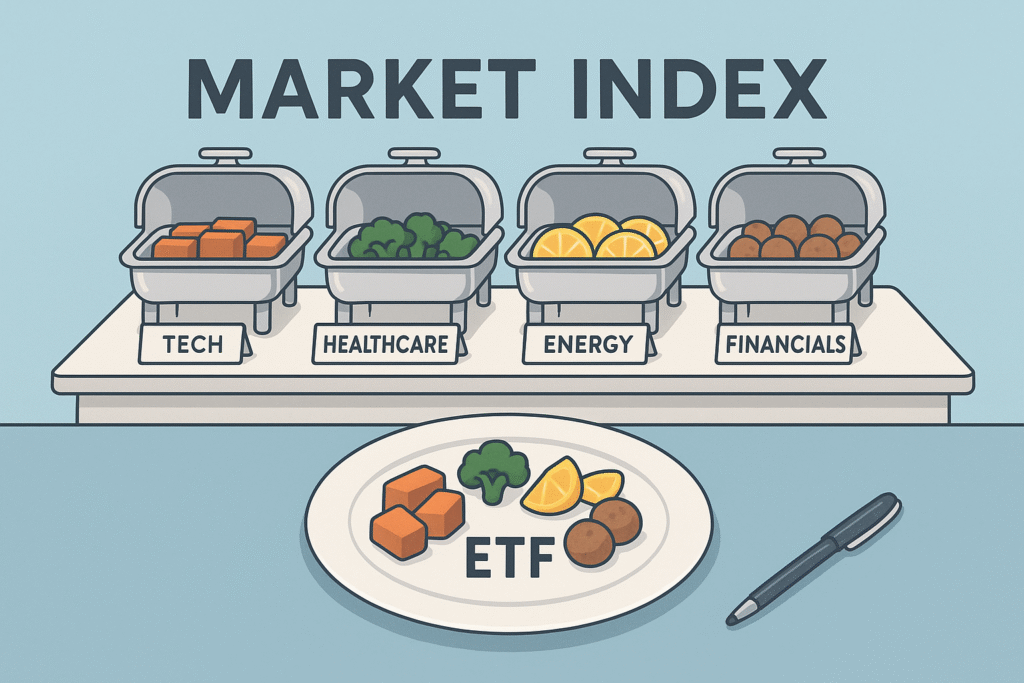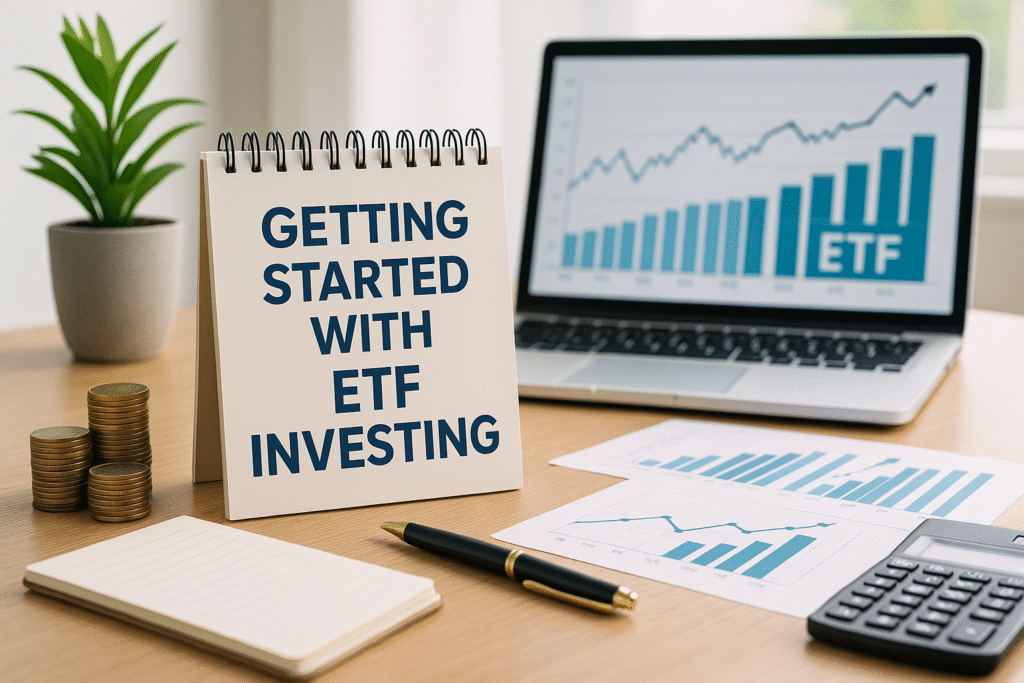Are you tired of spending countless hours researching individual stocks, only to see your investments underperform? 😩 Do you dream of building wealth without becoming a full-time market analyst? If so, you’re not alone. Many investors find themselves caught between the desire for financial growth and the reality of limited time and expertise. Fortunately, ETFs for lazy investors could be the perfect solution for those seeking simplicity and steady growth.
Enter ETFs – the lazy investor’s secret weapon. 🎯 These powerful investment vehicles have revolutionized the way people approach the stock market, offering a simple yet effective solution for those seeking to grow their wealth without sacrificing their free time. But what exactly are ETFs, and how can they work for you?
In this comprehensive guide, we’ll dive deep into the world of ETFs, exploring everything from their basic definition to advanced investment strategies. We’ll uncover the benefits that make ETFs so attractive to busy investors, debunk common misconceptions, and provide you with the knowledge you need to get started on your ETF investing journey. Whether you’re a complete novice or an experienced investor looking to optimize your portfolio, this article will equip you with the tools to harness the power of ETFs and take control of your financial future. 💪💼
What are ETFs?

A. Definition and basic concept
Exchange-Traded Funds (ETFs) are investment vehicles that combine the best features of stocks and mutual funds. They are baskets of securities that trade on stock exchanges, just like individual stocks. ETFs typically track a specific index, sector, commodity, or other asset, providing investors with a convenient way to gain exposure to a diverse range of investments through a single purchase.
Key characteristics of ETFs:
- Traded on stock exchanges
- Typically have lower fees than mutual funds
- Offer intraday trading
- Provide diversification
- Often track market indexes
B. How ETFs differ from mutual funds
| Feature | ETFs | Mutual Funds |
|---|---|---|
| Trading | Intraday on exchanges | End of day pricing |
| Minimum Investment | One share | Often higher minimums |
| Expense Ratios | Generally lower | Often higher |
| Tax Efficiency | More tax-efficient | Less tax-efficient |
| Management | Mostly passive | Active or passive |
ETFs offer several advantages over mutual funds, including greater flexibility in trading, lower costs, and improved tax efficiency. However, mutual funds may be more suitable for certain investment strategies or for investors who prefer active management.
C. Types of ETFs available
ETFs come in various types, catering to different investment objectives and risk tolerances:
- Stock ETFs: Track stock market indexes or sectors
- Bond ETFs: Invest in fixed-income securities
- Commodity ETFs: Track prices of commodities like gold or oil
- Currency ETFs: Follow foreign exchange rates
- Sector ETFs: Focus on specific industries
- Leveraged ETFs: Aim to amplify returns (higher risk)
- Inverse ETFs: Designed to profit from market declines
With this diverse range of options, investors can easily build a well-diversified portfolio using ETFs alone. Now that we understand what ETFs are and their various types, let’s explore the benefits they offer to investors.
Benefits of investing in ETFs

Low costs and fees
ETFs are renowned for their cost-effectiveness, making them an attractive option for lazy investors. Here’s a breakdown of the low costs and fees associated with ETFs:
| Fee Type | ETFs | Mutual Funds |
|---|---|---|
| Expense Ratio | 0.05% – 0.5% | 0.5% – 2.5% |
| Transaction Costs | Brokerage fees | Sales loads |
| Minimum Investment | Single share price | Often $1,000+ |
ETFs typically have lower expense ratios compared to actively managed mutual funds, resulting in significant savings over time. This cost efficiency allows investors to keep more of their returns, compounding their wealth effectively.
Diversification made easy
One of the key advantages of ETFs is the simplicity they offer in achieving diversification:
- Single transaction: Invest in hundreds or thousands of stocks with one purchase
- Sector-specific ETFs: Easily gain exposure to specific industries or market segments
- Global diversification: Access international markets without the complexities of direct foreign investment
Flexibility and liquidity
ETFs combine the best features of stocks and mutual funds, offering:
- Intraday trading: Buy and sell ETFs throughout the trading day at market prices
- Options strategies: Use advanced trading techniques like short selling or options
- No minimum holding period: Avoid redemption fees common with mutual funds
Tax efficiency
ETFs are structured to minimize taxable events, benefiting lazy investors who prefer a hands-off approach:
- In-kind creation/redemption process reduces capital gains distributions
- Lower turnover in index-tracking ETFs results in fewer taxable events
- Tax-loss harvesting opportunities for more advanced investors
With these tax advantages, ETFs allow investors to defer taxes and potentially increase their after-tax returns over time.
How ETFs work for lazy investors

A. Passive investment strategy
ETFs for lazy investors are the cornerstone of a passive investment strategy, perfect for those who prefer a hands-off approach. Moreover, unlike actively managed funds, ETFs typically track a specific index, offering broad market exposure without the need for constant monitoring or decision-making. This kind of effortless ETF strategy empowers even novice investors to grow wealth with minimal effort. For deeper insights into building a smart, low-maintenance portfolio, check out this guide from Schwab: 3 Ways to Build an All-ETF Portfolio.
- Benefits of passive investing with ETFs:
- Lower fees
- Reduced time commitment
- Minimized emotional decision-making
- Consistent market returns
| Active Investing | Passive Investing with ETFs |
|---|---|
| High fees | Low fees |
| Time-intensive | Low time commitment |
| Frequent trades | Buy and hold strategy |
| Potential for underperformance | Market-matching returns |
B. Automatic rebalancing
One of the most attractive features of ETFs for lazy investors is automatic rebalancing. As the underlying index changes, the ETF adjusts its holdings accordingly, maintaining the desired asset allocation without any effort from the investor.
- Advantages of automatic rebalancing:
- Maintains target asset allocation
- Reduces risk of overexposure to specific sectors
- Eliminates need for manual portfolio adjustments
- Ensures disciplined investing approach
C. Long-term growth potential
ETFs offer lazy investors excellent long-term growth potential by providing exposure to a wide range of assets and markets. By consistently investing in broad-market ETFs, investors can benefit from the overall growth of the economy and compound their returns over time.
- Factors contributing to long-term growth:
- Diversification across multiple sectors and companies
- Reinvestment of dividends
- Compounding returns over time
- Reduced impact of short-term market volatility
Now that we’ve explored how ETFs work for lazy investors, let’s delve into some popular ETF investment strategies that can further optimize your portfolio.
Popular ETF investment strategies

Index investing
Index investing is a cornerstone strategy for many ETF investors, aligning perfectly with the “lazy investor” approach. This method involves purchasing ETFs that track broad market indices, such as the S&P 500 or the Total Stock Market Index.
- Benefits of index investing:
- Low management fees
- Broad market exposure
- Minimal research required
- Consistent long-term performance
Here’s a comparison of popular index ETFs:
| ETF Name | Index Tracked | Expense Ratio | 5-Year Avg. Return |
|---|---|---|---|
| VOO | S&P 500 | 0.03% | 11.5% |
| VTI | Total US Stock | 0.03% | 10.9% |
| ITOT | Total US Stock | 0.03% | 10.8% |
Sector-specific ETFs
For investors looking to add a touch of active management to their lazy portfolio, sector-specific ETFs offer targeted exposure to particular industries or market segments.
- Popular sector ETFs:
- Technology (XLK)
- Healthcare (XLV)
- Consumer Discretionary (XLY)
- Energy (XLE)
Sector ETFs allow investors to capitalize on specific market trends or economic cycles without the need for extensive stock picking.
Geographic diversification
Expanding beyond domestic markets, geographic diversification through ETFs is an effortless way to gain international exposure. This strategy helps mitigate country-specific risks and taps into global growth opportunities.
- Types of geographic ETFs:
- Developed markets (EFA)
- Emerging markets (VWO)
- Single-country funds (EWJ for Japan)
- Global all-in-one (VT)
By combining these strategies, lazy investors can create a well-rounded, diversified portfolio with minimal effort. Next, we’ll explore how to choose the right ETFs for your specific investment goals and risk tolerance.
Choosing the right ETFs for your portfolio

Assessing your investment goals
Before diving into the world of ETFs, it’s crucial to define your investment objectives. Are you looking for long-term growth, regular income, or a balance of both? Your goals will guide your ETF selection process.
| Investment Goal | Suitable ETF Types |
|---|---|
| Growth | Stock ETFs, Sector ETFs |
| Income | Dividend ETFs, Bond ETFs |
| Balanced | Balanced ETFs, Asset Allocation ETFs |
Evaluating ETF performance metrics
When choosing ETFs, consider these key performance indicators:
- Total return
- Tracking error
- Sharpe ratio
- Beta
Understanding expense ratios
Expense ratios directly impact your returns. Lower is generally better, but don’t sacrifice quality for cost alone.
- Low-cost ETFs: 0.03% – 0.25%
- Average-cost ETFs: 0.25% – 0.50%
- Higher-cost ETFs: 0.50% and above
Considering trading volume and liquidity
Higher trading volume often means better liquidity, which can lead to tighter bid-ask spreads and easier trading. Look for ETFs with:
- Average daily trading volume of at least 100,000 shares
- Assets under management (AUM) of $50 million or more
Now that you understand how to choose the right ETFs for your portfolio, let’s address some common misconceptions about these investment vehicles.
Common misconceptions about ETFs

A. ETFs are only for beginners
Contrary to popular belief, ETFs for lazy investors are not just for novice investors. While they are indeed an excellent starting point for beginners due to their simplicity and low barriers to entry, this no-fuss ETF investing approach is also widely used by seasoned investors and financial institutions. Moreover, their flexibility, low costs, and ability to offer instant diversification make them a strategic asset across experience levels. To dive deeper, check out BlackRock’s guide to understanding ETFs.
- Diversification: ETFs offer instant diversification, which is crucial for both beginners and experienced investors.
- Cost-efficiency: Low expense ratios make ETFs attractive for long-term wealth building.
- Flexibility: ETFs can be traded throughout the day, unlike mutual funds.
- Tax efficiency: Many ETFs have lower turnover, potentially reducing capital gains taxes.
| Investor Type | Benefits of ETFs |
|---|---|
| Beginners | Easy to understand, low minimum investments |
| Intermediate | Portfolio diversification, sector-specific exposure |
| Advanced | Hedging strategies, tactical asset allocation |
B. All ETFs are created equal
This misconception couldn’t be further from the truth. ETFs come in various types, each with its own risk profile, investment strategy, and underlying assets. Some key differences include:
- Asset class: Stocks, bonds, commodities, or real estate
- Geographic focus: Domestic, international, or global
- Sector-specific: Technology, healthcare, energy, etc.
- Investment style: Growth, value, or blend
- Management approach: Passive (index-tracking) or active
C. ETFs are risk-free investments
While ETFs offer diversification, they are not without risks. Different types of ETFs carry varying levels of risk:
- Market risk: ETFs are subject to overall market fluctuations
- Sector risk: Sector-specific ETFs can be volatile if the industry faces challenges
- Liquidity risk: Some niche ETFs may have lower trading volumes
- Tracking error: ETFs may not perfectly mirror their underlying index
Investors should always research and understand the specific risks associated with each ETF before investing. By dispelling these common misconceptions, investors can make more informed decisions about incorporating ETFs into their investment strategies.
Getting started with ETF investing

Opening a brokerage account
To begin your ETF investing journey, you’ll need to open a brokerage account. This is your gateway to purchasing and managing ETFs. Here’s a quick guide to help you choose the right brokerage:
- Compare fees and commissions
- Check for ETF availability
- Evaluate user interface and mobile app
- Look for educational resources
- Consider customer support options
| Brokerage Feature | Why It Matters |
|---|---|
| Low fees | Keeps more money in your investments |
| Wide ETF selection | Allows for diverse portfolio building |
| User-friendly platform | Makes trading and management easier |
| Educational tools | Helps you make informed decisions |
| Reliable support | Assists when you have questions or issues |
Researching and selecting ETFs
Once your account is set up, it’s time to choose your ETFs. Focus on these factors:
- Expense ratio: Lower is generally better
- Trading volume: Higher liquidity can mean easier buying and selling
- Track record: Look for consistent performance relative to the benchmark
- Underlying index: Ensure it aligns with your investment goals
Creating a balanced ETF portfolio
A well-balanced portfolio is key to successful lazy investing. Consider the following allocation strategy:
- 60% broad market stock ETFs
- 30% international stock ETFs
- 10% bond ETFs
This balance provides diversification while maintaining growth potential. Adjust percentages based on your risk tolerance and investment timeline.
Setting up automatic investments
Leverage the power of dollar-cost averaging by setting up recurring investments. Most brokerages offer this feature, allowing you to:
- Choose your ETFs
- Set investment amount
- Select frequency (e.g., monthly)
- Let the system handle the rest
This approach removes emotion from investing and ensures consistent portfolio growth over time.
Conclusion

ETFs have revolutionized the investment landscape, offering a simple yet powerful tool for lazy investors to build diverse portfolios with minimal effort. These financial instruments provide access to a wide range of assets, from stocks and bonds to commodities and real estate, all within a single, easily traded package. By understanding the benefits, strategies, and common misconceptions surrounding ETFs, investors can make informed decisions and tailor their portfolios to meet their financial goals.
For those looking to embark on their ETF investment journey, remember that simplicity is key. Start by identifying your investment objectives, risk tolerance, and time horizon. Then, select a few broad-based ETFs that align with your goals and gradually build your portfolio. With their low costs, tax efficiency, and potential for long-term growth, ETFs truly are the lazy investor’s secret weapon for achieving financial success. For fresh strategies and smarter money habits, visit the Investillect blog. 💡📈💰

